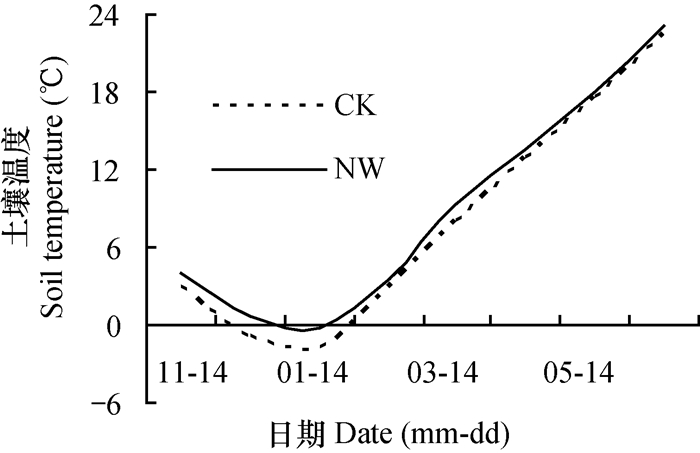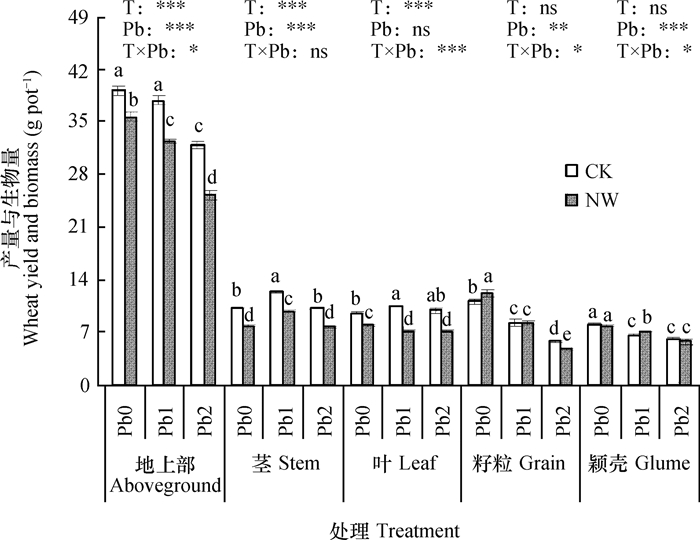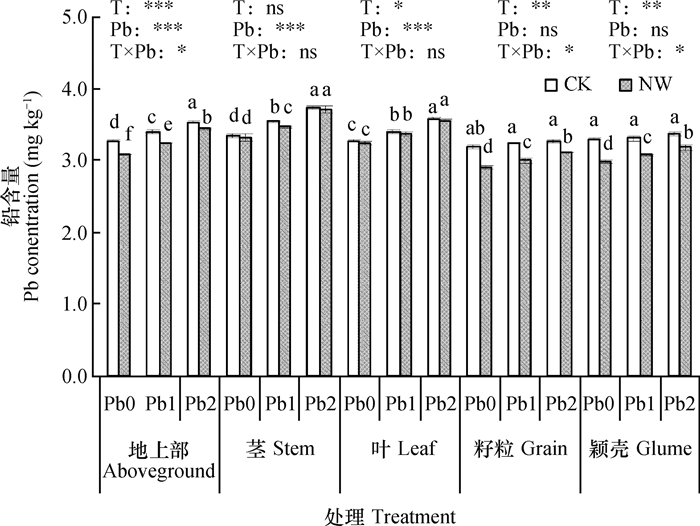2. 濮阳职业技术学院,河南濮阳 457000
冬小麦是中国北方的重要粮食作物,冬小麦种植区近年来正遭受着白天与夜间温度增加的气候变暖危害[1]。作为最重要的气候变化问题之一,气候变暖已经成为全球科学家和公众密切关注的重要问题[2]。政府间气候变化专门委员会(IPCC)认为全球地表气温预计到21世纪末将上升1.4~5.8 ℃,夜间增温幅度将是白天增温幅度的3倍[2-3]。白天与夜间增温幅度的明显差异势必影响小麦的生产[4],而且白天与夜间增温对小麦生长与生产的影响存在差异[1-4],阐明夜间增温对小麦生长的影响对制定生产对策、科学布局小麦农业生产至关重要。当前模拟夜间增温手段并不一致,大多数主要利用温度控制箱或温室来模拟夜间升温[5]、少数采用田间被动或主动式增温[6-7]方式,后者因更接近田间环境结果更真实。尽管夜间增温有致小麦增产[6]、减产[8-9]或无影响[10]等不同结果,但是鉴于夜间增温将增加土壤水分蒸腾[11]、土壤呼吸[12]与根系生长[13],普遍认同全球变暖背景下的夜间增温将会影响小麦等作物的生长与生产[4-5]。夜间增温影响作物生长,将会改变根系对元素的吸收[14],并潜在地影响元素物质在植物体内的再分配利用[15],进而对物质生产与品质造成影响[16]。伴随着工业快速发展,农业土壤中污染物质富集并危害作物生长与粮食生产,是亟待解决的重要生产问题。而气候变暖背景下重金属污染元素(例如,铅)的生物地球化学循环是否改变及其对作物生产的危害亟待明确。
铅(Pb)是土壤中主要的重金属污染元素,随汽车尾气、灰尘等进入农田且移除困难,可导致植物含量超标、危害作物生长[17]、造成粮食污染与减产[18]。由于夜间增温能潜在的影响小麦吸收矿质元素[14],故也可能影响Pb污染元素的吸收与分配,其影响态势对预判气候变暖背景下Pb威胁对粮食生产及食用安全的影响极其重要,但目前缺乏相关研究。揭示夜间增温对Pb素在作物中富集、迁移的影响有助于理解全球变暖背景下Pb素生物地球化学循环与制定小麦科学生产对策。本试验采用小麦全生育期田间被动式夜间增温试验平台[6]与铅污染客土培养试验相合开展复合研究,分析了夜间增温对不同浓度土壤Pb污染下小麦产量与地上部干物质生产分配、Pb素在小麦地上部各器官中富集与迁移的影响,以期进一步理解气候变暖下小麦对污染元素吸持的特征与机制,并为制定农田污染元素防控管理措施提供科学依据。
1 材料与方法 1.1 试验区概况试验于2013—2014年在河南科技大学周山校区农场(34°38'N,112°22'E)进行。试验区属于暖温带半湿润季风气候,年均气温在13.7℃左右,年均降水量约650.2 mm,该实验区以雨养农业为主。试验土壤采自距豫西某金铅矿冶炼厂附近不同距离但理化性质和肥力较一致的农田耕层,为Pb污染土壤,其他重金属元素检测未超标,土壤类型为褐土。供试土壤理化性质为:有机质9.1 g kg-1、全氮1.28 g kg-1、有效磷2.4 mg kg-1、速效钾105.5 mg kg-1、容重1.12 g cm-3、pH 7.8、有效铅36.8~415.7 mg kg-1。
1.2 试验设计采用增温与Pb污染裂区设计,增温(2个环境)为主处理,Pb处理(3个浓度)为副处理。增温处理设增温区(NW)与常温对照区(CK),Pb处理根据土壤含Pb量差异并参照国家《土壤环境质量标准(GB15618-1995)》分为无污染(Pb0)、轻度污染(Pb1)、重度污染(Pb2)3个水平,3次重复。其中,田间增温区采用夜间截留地表长波辐射的被动式夜间增温系统[6]进行增温,主要由可调节升降高度的水平组架、组架上可收放的覆盖材料构成;采用全生育期增温,每天增温覆盖时间从19:00至第2天7:00,覆盖高度为冠层正上方20 cm处,小麦冠层四周无遮挡;在降水时增温区无遮盖以减少降水差异影响。Pb0土壤中Pb含量为36.8 mg kg-1(接近一级土壤Pb含量标准,自然背景值≤35 mg kg-1)、Pb1为153.4 mg kg-1(介于一级与二级土壤Pb含量标准之间)、Pb2为415.7 mg kg-1(介于二级与三级土壤Pb含量标准之间)。
Pb污染处理采用盆钵栽实验随机排列埋入NW和CK(各9个)土中进行,以盆钵上沿高出土表2 cm为适,共18个盆。试验盆钵为市售PVC大桶(高60 cm,直径50 cm),每盆装干土35 kg。装盆前,拣去可见土壤根茬、石块等侵入物,将不同Pb浓度土壤分别过2 cm孔径筛混均。根据大田常规施肥量折算每盆所添加肥料为氮(N)用量每盆2.1 g(折合约N 135 kg hm-2)、磷(P2O5)和钾(K2O)肥用量分别为每盆1.4 g(约合P2O5或K2O 90 kg hm-2),其中,氮肥的50%(尿素)、磷肥(过磷酸钙)、钾肥(氯化钾)一次性溶解于水后浇于各盆中,并向每盆中补水使土壤含水量为70%WPFS,另外50%氮肥于返青定植后溶水施入;浇水2 d后,于2013年11月5日按35株/盆播种,返青期定植25株,于2014年5月27日收获。供试小麦品种为本地区主栽品种中麦175。整个生育期仅在连续20多天无降水的期间(2014年4月11日)每盆等量一次性补水1 L防止死亡外,再无人为灌水。成熟期收获植株地上部进行分析。
1.3 测定内容和方法实验期间利用自动温度记录仪(JC12BZDR-41,北京精诚华泰仪表有限公司)测定土壤耕层温度和冠层温度,每10 min记录1次,将记录温度平均以获得各处理小区的平均温度,因冠层温度不完整,本研究结果仅分析夜间时段的土壤平均温度。
小麦按秸秆、叶、颖壳、籽粒4个不同组织进行收获,并在105 ℃的温度下杀青30 min后在70℃烘48 h称重。然后将各组织粉碎、过筛用以测定Pb。Pb含量测定采用酸溶解-原子吸收光谱仪测定方法[19];各组织Pb积累量(μg kg-1)为各组织的Pb含量与干物重之积;地上部Pb积累量为各组织积累量之和。
1.4 数据处理不同组织(秸秆、叶、颖壳、籽粒)的Pb富集系数为该植物组织内Pb含量/土壤中的Pb含量[20],其大小表征该植物组织积累Pb元素的能力强弱;Pb由茎到叶、颖壳、籽粒的迁移系数分别为叶、颖壳、籽粒中的Pb含量/茎中的Pb含量[20],其大小表征Pb在植物地上部组织中转运与再分配能力的强弱。数据通过SSPS19.0统计软件,通过ANOVA对不同温度(T)与Pb污染(Pb)因素的效应进行方差统计分析,显著水平为p<0.05,利用Microsoft Office Excel 2003制图。
2 结果 2.1 夜间增温系统的增温效果整个生育期,夜间增温区(NW)夜间土壤温度明显高于常温环境(CK,对照)区域(图 1)。整个小麦生长期内,增温区内土壤温度在-2.2~23℃间变化,平均温度为7.0℃,对照区域则在-3.5~22.5℃间变化,平均温度为5.9℃,整个生育期内平均增温1.1℃,表明本研究中的被动式夜间增温系统能实现增加土壤-植物系统温度的效果。

|
图 1 田间被动式夜间增温系统的增温变化 Fig. 1 Variation of temperature as affected by the passive night warming system in field |
夜间增温对小麦籽粒产量的影响受土壤Pb污染程度制约(图 2)。小麦产量随Pb污染程度的增加呈减产趋势,增温与常温环境在Pb污染(Pb1和Pb2)处理较无污染(Pb0)处理分别显著降低31.3%~60.2%和25.5%~48.4%。夜间增温显著增加Pb0处理小麦产量8.3%,显著降低重度污染(Pb2)处理16.4%但却对轻度污染(Pb1)处理无影响。因素分析表明,增温与Pb污染对产量呈显著的交互效应。

|
图 2 夜间增温与铅污染处理对小麦产量和地上部不同组织生物量的影响 Fig. 2 Effects of night warming and Pb pollution on yield and biomass of the aboveground tissues of wheat 注:不同字母表示同一植物组织处理间差异显著(p<0.05);ANOVA因素分析中*、**与***分别表示显著水平为p<0.05、p<0.01与p<0.001,ns表示不显著。下同 Note:Different letters indicate significant differences between the same plant tissues in different treatments at the 0.05 level. *,**,and *** in ANOVA denotes significant difference at p < 0.05,p < 0.01 and p < 0.001,respectively;and ns means not significant. The same below |
增温与常温环境下小麦地上部、籽粒与颖壳干物质重均随Pb污染加重呈下降态势,但茎干重在Pb1处理相比Pb0处理在增温与常温条件下均显著增加(图 2)。增温分别显著降低所有处理小麦地上部、茎、叶干物质积累8.8%~21.0%、20.7%~24.3%、8.8%~21.0%。增温具有降低Pb0和Pb2处理中颖壳干重趋势,却显著增加了Pb1中的颖壳重6.0%。方差分析表明,温度与Pb污染对小麦地上部及其各部位干重的作用并不一致。
2.3 夜间增温对小麦地上部铅含量与积累量的影响植物地上部、茎、叶中Pb含量在增温与常温环境中均随着Pb污染加重而增加;但籽粒、颖壳中Pb含量在常温环境下表现为与Pb污染程度无关,而增温环境中则表现为随Pb污染加重而增加(图 3)。夜间增温显著降低了全部污染处理的植株地上部、籽粒与颖壳中Pb含量,但对茎、叶中Pb含量基本无显著影响。表明夜间增温具有抑制小麦植株地上部和籽粒中吸收Pb的作用。方差分析表明,Pb污染程度与温度对植株地上部、籽粒、颖壳中Pb含量具有显著的交互作用。

|
图 3 夜间增温处理下小麦地上不同组织的铅含量 Fig. 3 Lead contents in aboveground tissues of the wheat affected by night warming |
Pb在地上部及其不同地上组织中的积累在增温与常温环境下随Pb污染加重的变化规律呈现出与小麦干物质积累类似规律(图 4、图 2)。不同Pb污染处理下,增温具有降低地上部及其不同地上组织中Pb积累量的趋势,但受器官与污染处理差异制约。其中,增温分别显著降低3个Pb处理下小麦地上部、茎和叶中Pb积累量14.0%~23.3%、22.5%~24.9%和17.9%~31.8%,分别显著降低籽粒中Pb积累量7.6%(Pb1)和6.8%(Pb2)和颖壳中Pb积累量12.0%(Pb0)和13.9%%(Pb2)。温度和Pb污染显著影响地上部、茎、叶和颖壳中的Pb积累,但温度未对籽粒中Pb积累量呈现显著作用(图 4)。

|
图 4 夜间增温处理下小麦地上不同组织的铅积累量 Fig. 4 Lead accumulations in aboveground tissues of the wheat as affected by night warming |
地上部不同组织中Pb的富集系数在常温与增温环境相同Pb污染处理下均表现为茎>叶>颖壳≥籽粒(表 1),表明进入小麦地上部的Pb主要存储于茎秆中、进入籽粒中最少。随着Pb污染加重,同一组织的Pb富集系数在常温与增温条件下均呈降低,表明小麦通过降低Pb在地上部的相对积累来适应土壤Pb污染胁迫的增加。夜间增温显著降低了Pb0处理Pb在茎、叶、籽粒和颖壳中的富集系数和Pb1处理Pb在茎、籽粒和颖壳中的富集系数,但没有显著影响Pb2处理Pb在各器官的富集系数。表明夜间增温条件下小麦通过调控自身对Pb的吸收适应Pb污染胁迫可能有一定的阈值区间。
|
|
表 1 不同处理下小麦地上部不同组织中铅富集系数和迁移系数 Table 1 Lead bioaccumulation factor (BAF) and translocation factor (TF) in aboveground tissues of the wheat affected by Pb treatment |
常温与增温环境下相同Pb污染处理表征Pb素由茎向叶、籽粒和颖壳转移能力的迁移系数表现为叶/茎>颖壳/茎>籽粒/茎(表 1)。增温显著降低了Pb0、Pb1、Pb2处理中表征Pb由茎向籽粒、颖壳转移能力的Pb迁移系数,却均未对由茎向叶的迁移系数产生显著影响。表明夜间增温将抑制Pb由茎向籽粒、颖壳的转移,但不会影响向叶的转移。
3 讨论被动式夜间增温系统对土壤-植物系统温度增加,主是通过截留地面夜晚长波辐射达到增温目的,张明乾等[13]也观测到夜间增温能增加土壤温度。夜间增温增加了无污染处理小麦的产量,与众多研究结果一致[6-7, 21]。夜间增温增加冬小麦产量,可能是因为温度升高直接降低了冻害对小麦的影响[7];也可能是由于气候变暖导致冬后生育期提前,这间接避免了花后小麦灌浆期的高温胁迫[21-22]。但与夜间增温将导致小麦减产[1, 23]或无影响[10]的报道不一致。鉴于产量构成因子(如穗粒数、千粒重、穗数)响应夜间增温的态势受温度年型、研究区域、增温时期、小麦品种和土壤养分水分供应之间的差异制约[4, 9, 22],由于诸多因素差异使得夜间增温对产量构成因素的影响不完全一致[4, 9],可能直接导致了小麦产量响应夜间增温的差异。Pb污染导致小麦减产且随污染程度增加而加大,是由于重金属Pb对植物胁迫伤害所致[24]。夜间增温未影响轻污染处理却显著降低重污染处理小麦籽粒产量,表明夜间增温可缓解轻度Pb污染对小麦生产的危害,却无法消除重污染的危害。先前研究发现夜间增温可增加土壤中元素活性[13],故Pb污染土壤中Pb活性可能增加,进而导致小麦生长遭受Pb胁迫危害程度增加,加剧了小麦减产。增温显著降低全部Pb处理中单株小麦地上部、茎、叶干物质积累,可能是由于夜间增温会促进碳水化合物向地下分配,促进根系生长与物质积累而减少了地上植株的干物质积累[13]所致,同时Pb污染胁迫使小麦自我调控效应增强;也可能由于夜间增温组小麦生长较快、易遭受冻害与干旱胁迫[22]以及Pb胁迫共同作用导致地上部分生物量减少[25]。然而也有报道夜间增温将提高小麦地上部分生物量[26],并认为是由于小麦生长后期增温导致根系生物量下降而增加地上生物量所致。不一致结果表明夜间增温对小麦物质积累与产量形成的影响较复杂。
夜间增温显著降低了全部污染处理的植株地上部Pb含量,表明夜间增温抑制了小麦地上部吸持Pb素,这可能是由于夜间增温增加了小麦根系对营养元素的吸持[13]、由于养分间拮抗效应[17]导致Pb吸收量减少或者较多的Pb被截留在根系中而运输到地上部的量减少,但具体原因仍有待深入研究。增温对茎、叶中Pb含量几乎无影响却显著降低其积累量,主要是夜间增温显著降低茎叶生物量所致(图 2)。增温导致Pb污染胁迫条件下小麦籽粒中Pb积累量显著降低,轻度污染下由于籽粒重无变化故应主要是由于Pb含量显著降低所致,而重度污染下是由于Pb含量与籽粒重共同降低所致。尽管物质积累与Pb含量联合作用可解释Pb积累量的变化,然而植物在增温与铅污染复合背景下的适应调整是深层次的内因,这有待进一步研究。忽略温度环境差异,Pb富集系数呈现出茎>叶>颖壳≥籽粒的规律以及Pb由茎向其他组织转移大小的迁移系数也呈现出叶>颖壳>籽粒,表明Pb素在籽粒中的富集与积累能力较小。因富集系数与迁移系数均低于1,说明小麦不是Pb富集植物[17],而且Pb在地上部主要存储在茎中,在植物体内再利用的移动性较差[17],这或许解释造成Pb在小麦地上部分布差异的原因。夜间增温降低了无污染与轻度污染处理地上组织的Pb富集系数但对重度污染处理无影响,富集系数的降低主要是由于积累量的相对下降所致,显然夜间增温条件下小麦调控自身对Pb的吸收以适应Pb胁迫存在一定的污染范围。增温显著降低全部处理由茎向籽粒、颖壳转移的Pb迁移系数,表明夜间增温使Pb在植物体内再利用的移动性变差。这可能是由于夜间增温加剧了Pb素对茎、叶的毒害,进而降低了Pb素从茎和叶到籽粒和颖壳的运输[13, 17]。
本研究综合表明,夜间增温将可能增加增食生产,而且Pb素在籽粒含量与积累量及由茎向籽粒的转移能力下降,可能预示着未来气候变暖背景下小麦粮食生产避免遭受Pb污染威胁的品质安全性将提高。
4 结论夜间增温能增加小麦籽粒生产但却不利于地上部干物质积累,Pb污染胁迫所产生的不利影响将抵消增温呈现的正效应。夜间增温能抑制地上部对Pb素吸收与积累,减少Pb素向籽粒转运,暗示气候变暖对小麦优质生产较有利,将降低小麦粮食生产中因土壤污染所导致重金属Pb污染的潜在风险。
| [1] |
谭凯炎, 房世波, 任三学, 等. 非对称性增温对农业生态系统影响研究进展. 应用气象学报, 2009, 20: 634-641. Tan K Y, Fang S B, Ren S X, et al. Asymmetric trends of daily maximum and minimum temperature in global warming and its effects on agriculture ecosystems (In Chinese). Journal of Applied Meteorology Science, 2009, 20: 634-641. (  0) 0) |
| [2] |
IPCC. Climate change 2007: Summary for policymakers. [2016-2-20]. http://www.ipcc.ch/
(  0) 0) |
| [3] |
Easterling D R, Peterson T C, Karl T R. Maximum and minimum temperature trends for the globe . Science, 1997, 277: 364-367. DOI:10.1126/science.277.5324.364
(  0) 0) |
| [4] |
Lobell D B. Changes in diurnal temperature range and national cereal yields . Agricultural and Forest Meteorology, 2007, 145(3/4): 229-238.
(  0) 0) |
| [5] |
程相涵, 寇太记, 王俪睿, 等. 夜间增温对麦田系统影响的实验研究进展. 河南农业科学, 2017, 46(6): 23-28. Cheng X H, Kou T J, Wang L R, et al. Research progress in the effects of nighttime warming on wheat ecosystem (In Chinese). Journal of Henan Agricultural Sciences, 2017, 46(6): 23-28. (  0) 0) |
| [6] |
田云录, 陈金, 邓艾兴, 等. 开放式增温下非对称性增温对冬小麦生长特征及产量构成的影响. 应用生态学报, 2011, 22(3): 681-686. Tian Y L, Chen J, Deng A X, et al. Effects of asymmetric warming on the growth characteristics and yield components of winter wheat under free air temperature increased (In Chinese). Chinese Journal of Applied Ecology, 2011, 22(3): 681-686. (  0) 0) |
| [7] |
Fang S B, Cammarano D, Zhou G S, et al. Effects of increased day and night temperature with supplemental infrared heating on winter wheat growth in North China . European Journal of Agronomy, 2015, 64: 67-77. DOI:10.1016/j.eja.2014.12.012
(  0) 0) |
| [8] |
Wilkens P, Singh U. A code-level analysis for temperature effects in the CERES models//White J. Modeling temperature response in wheat and maize. E1 Batan, Mexico: CIMMYT, 2001: 17
(  0) 0) |
| [9] |
房世波, 谭凯炎, 任三学. 夜间增温对冬小麦生长和产量影响的实验研究. 中国农业科学, 2010, 43(15): 3251-3258. Fang S B, Tan K Y, Ren S X. Winter wheat yields decline with spring higher night temperature by controlled experiments (In Chinese). Scientia Agricultura Sinica, 2010, 43(15): 3251-3258. DOI:10.3864/j.issn.0578-1752.2010.15.025 (  0) 0) |
| [10] |
Fang S B, Tan K Y, Ren S X, et al. Field experiments in North China show no decrease in winter wheat yields with night temperature increased by 2.0-2.5 ℃ . Science China Earth Sciences, 2012, 55: 1021-1027. DOI:10.1007/s11430-012-4404-5
(  0) 0) |
| [11] |
江晓东, 苏海报, 王晓梅, 等. 昼夜不对称增温对麦田土壤水分的影响. 灌溉排水学报, 2014, 33(4/5): 283-286. Jiang X D, Su H B, Wang X M, et al. Effect of asymmetric between day and night warming on soil moisture in wheat field (In Chinese). Journal of Irrigation and Drainage, 2014, 33(4/5): 283-286. (  0) 0) |
| [12] |
张耀鸿, 楚岱蔚, 谢晓金, 等. 夜间增温对麦田土壤呼吸速率的影响. 农业环境科学学报, 2013, 32(7): 1389-1395. Zhang Y H, Chu D W, Xie X J, et al. Effect of nighttime warming on soil respiration in winter wheat soil (In Chinese). Journal of Agro-Environment Science, 2013, 32(7): 1389-1395. (  0) 0) |
| [13] |
张明乾, 陈金, 郭嘉, 等. 夜间增温对冬小麦根系生长和土壤养分有效性的影响. 应用生态学报, 2013, 24(2): 445-450. Zhang M Q, Chen J, Guo J, et al. Effects of nighttime warming on winter wheat root growth and soil nutrient availability (In Chinese). Chinese Journal of Applied Ecology, 2013, 24(2): 445-450. (  0) 0) |
| [14] |
Sardans J, Peñuelas J, Prieto P, et al. Drought and warming induced changes in P and K concentration and accumulation in plant biomass and soil in a Mediterranean shrubland . Plant and Soil, 2008, 306: 261-271. DOI:10.1007/s11104-008-9583-7
(  0) 0) |
| [15] |
Jonassona S, Castro J, Michelsen A. Litter, warming and plants affect respiration and allocation of soil microbial and plant C, N and P in arctic mesocosms . Soil Biology & Biochemistry, 2004, 36: 1129-1139.
(  0) 0) |
| [16] |
Li N, Wang G X, Yang Y, et al. Plant production, and carbon and nitrogen source pools, are strongly intensified by experimental warming in alpine ecosystems in the Qinghai-Tibet Plateau . Soil Biology & Biochemistry, 2011, 43: 942-953.
(  0) 0) |
| [17] |
段德超, 于明革, 施积炎. 植物对铅的吸收、转运、累积和解毒机制研究进展. 应用生态学报, 2014, 25(1): 287-296. Duan D C, Yu M G, Shi J Y. Research advances in uptake, translocation, accumulation and detoxification of Pb in plants (In Chinese). Chinese Journal of Applied Ecology, 2014, 25(1): 287-296. (  0) 0) |
| [18] |
Wu G, Kang H B, Zhang X Y, et al. A critical review on the bio-removal hazardous heavy metals from contaminated soils:Issues, progress, concerns and opportunities . Journal of Hazardous Materials, 2010, 174(1/3): 1-8.
(  0) 0) |
| [19] |
鲁如坤. 土壤农业化学分析方法. 北京: 中国农业科技出版社, 2000, 146-271. Lu R K. Analytical Methods for Soil and Agro-chemistry (In Chinese). Beijing: China Agricultural Science and Technology Press, 2000, 146-271. (  0) 0) |
| [20] |
Rezvani M, Zaefarian F. Bioaccumulation and translocation factors of cadmium and lead in Aeluropus littoralis . Australian Journal of Agricultural Engineering, 2011, 2(4): 114-119.
(  0) 0) |
| [21] |
Sadras V O, Monzon J P. Modelled wheat phenology captures rising temperature trends:Shortened time to flowering and maturity in Australia and Argentina . Field Crops Research, 2006, 99(2/3): 136-146.
(  0) 0) |
| [22] |
权畅, 景元书, 谭凯炎. 气候变化对三大粮食作物产量影响研究进展. 中国农学通报, 2013, 29(32): 361-367. Quan C, Jing Y S, Tan K Y. Progress in research of impacts of climate change on yield of three major grain crops (In Chinese). Chinese Agricultural Science Bulletin, 2013, 29(32): 361-367. (  0) 0) |
| [23] |
Asseng S, Ewert F, Martre P, et al. Rising temperatures reduce global wheat production . Nature Climate Change, 2015, 5(2): 143-147. DOI:10.1038/nclimate2470
(  0) 0) |
| [24] |
Liu D, Jiang W, Wang W, et al. Effects of lead on root growth, cell division, and nucleolus of Allium cepa . Environmental Pollution, 1994, 86(1): 1-4. DOI:10.1016/0269-7491(94)90002-7
(  0) 0) |
| [25] |
Wang H L, Gan Y T, Wang R Y, et al. Phenological trends in winter wheat and spring cotton in response to climate changes in Northwest China . Agricultural and Forest Meteorology, 2008, 148(8/9): 1242-1251.
(  0) 0) |
| [26] |
吴杨周, 陈健, 胡正华, 等. 水分减少与增温处理对冬小麦生物量和土壤呼吸的影响. 环境科学, 2016, 37(1): 25-33. Wu Y Z, Chen J, Hu Z H, et al. Effects of reduced water and diurnal warming on winter-wheat biomass and soil respiration (In Chinese). Environmental Science, 2016, 37(1): 25-33. (  0) 0) |
2. Puyang Vocational and Technical College, Puyang, Henan 457000, China
 2018, Vol. 55
2018, Vol. 55

